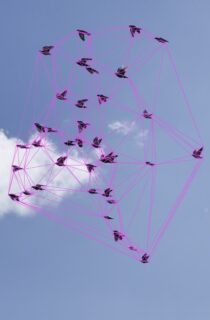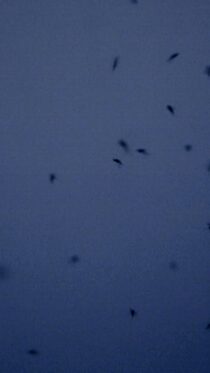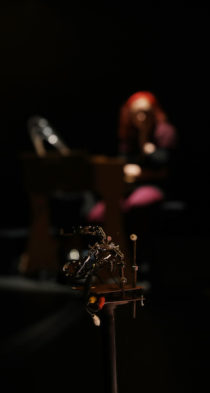Truce: Strategies for Post-Apocalyptic Computation (2009)
|
Interactive Installation in Collaboration with Ali Momeni Honorary mention at Ars Electronica 2009 Exhibition at SIGGRAPH Art Gallery, Yokohama 2009 Exhibition at Palais de Tokyo, Paris 2010 Exhibition at Musée des Beaux Arts, Nantes 2012 BBC News from Exhibition at Sonica Festival, Glasgow 2013 related posts PDF Documentation (2.5Mb) 2009 Spark Festival, Minneapolis, USA Русский, Español, 日本語, Français, English In their seminal paper “Flying in Tune: Sexual recognition in mosquitoes”, Gabriella Gibson and and Ian Russell from the University of Greenwich discovered an inspiring phenomenon: male mosquitoes change their buzzing frequency to match that of a female mosquito. This synchronization brings their wing beats to within a millisecond or less of one another. The authors suggest that this phenomenon facilitates the mosquitoes’ ability to copulate mid-flight. We take advantage of this phenomenon to engage the mosquitoes in song, inspired by the North Indian classical vocal tradition of Dhrupad. Similarly to my piece “Experiments in Fish/Machine Communication” our installation explores reciprocal musical interactions between the mosquito and the computer. The computer produces a stimulus sound to which the living mosquitoes synchronize. Subsequently, the computer sings a third voice that responds to the musical inflections of the mosquitoes’ buzz. These three voices come in and out of harmony depending on the mosquitoes propensity to maintain its sync with the stimulus signal. In our installation, each mosquito is equipped with a loud-speaker for providing the stimulus signal, a sensitive microphone for picking up the mosquitoes’ buzz, a camera for giving us a closer look at the insect, a kinetic component that allows the mosquitoes to rest every few minutes and a light bulb that shows the mosquito’s activity. Notes for the visitors to the gallery were as follows: We invite our visitors to interact with the mosquitoes. This interactions must be gentle; we request that you limit your interactions to one of two possibilities:
Please avoid applying pressure to the mosquito, touching its wings, or touching the wire to which the mosquito is attached. These actions can hurt the mosquito, free the mosquito or produce undesirable sounds. We wish to give special thanks to Ann Falon, a researcher at the University of Minnesota. Without her generous offer of the facilities and mosquitoes of her St. Paul laboratory, this project would not have been possible. Video Gallery click to play A mosquito is attached to a thin wire with a drop of beeswax Tickling the Mosquito during tests with light controller Closeup of a male mosquito as projected during the installation Recording two females with a DPA4060 microphone Testing the mosquito’s reaction to removing it’s resting place Japan declares Truce: . Links Minnesota Daily Newspaper Slideshow . “Truce” was supported by Pro Helvetia. |


























